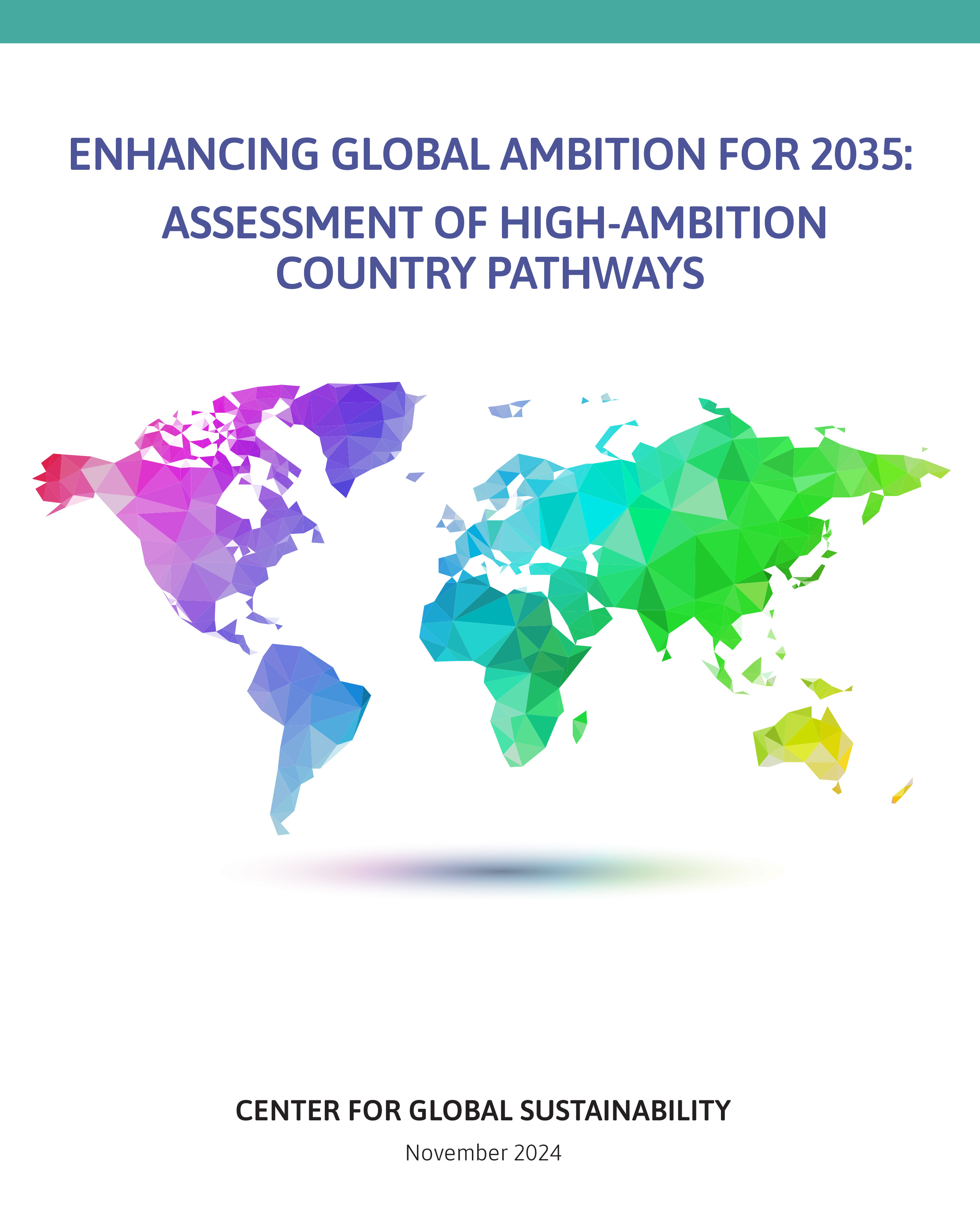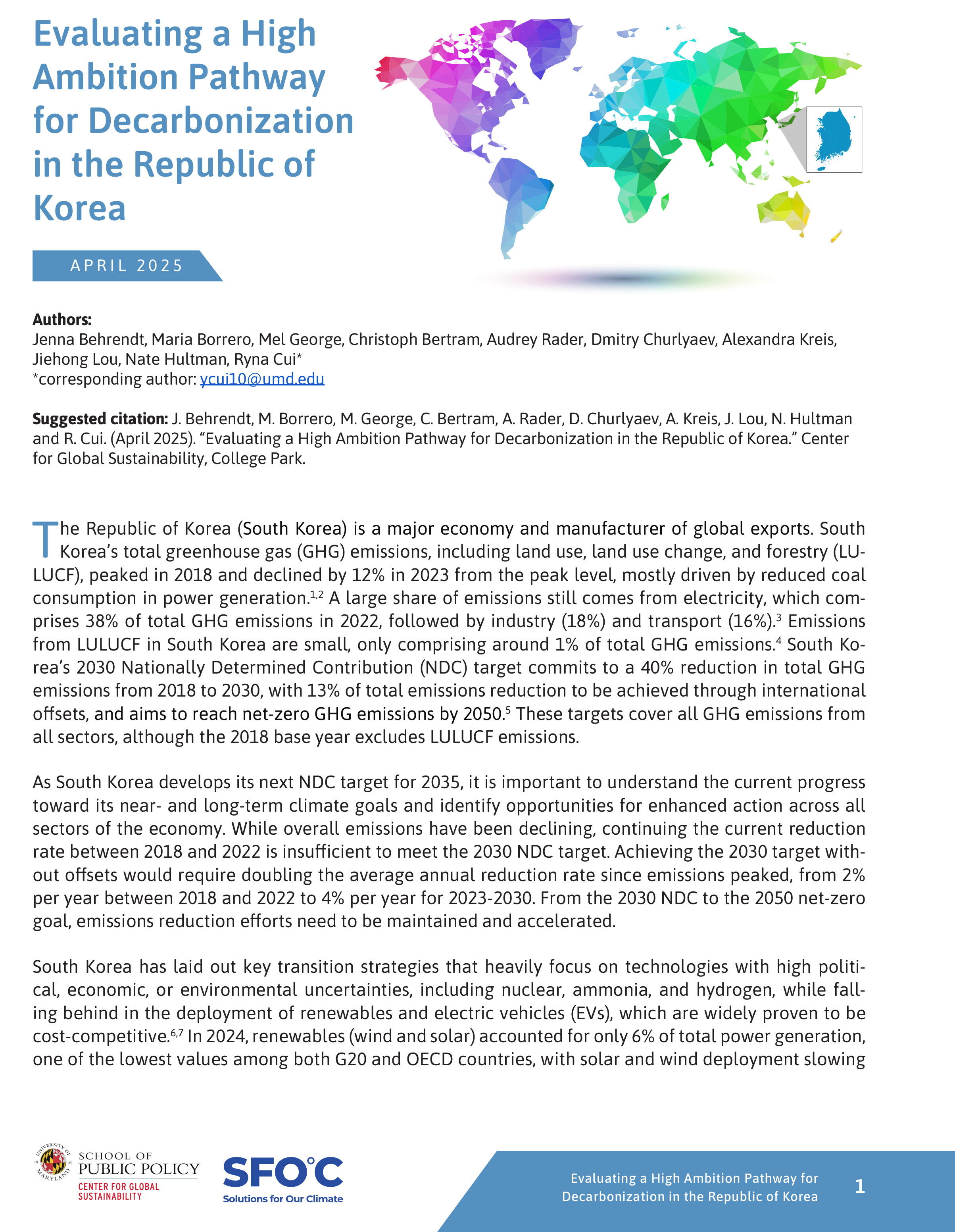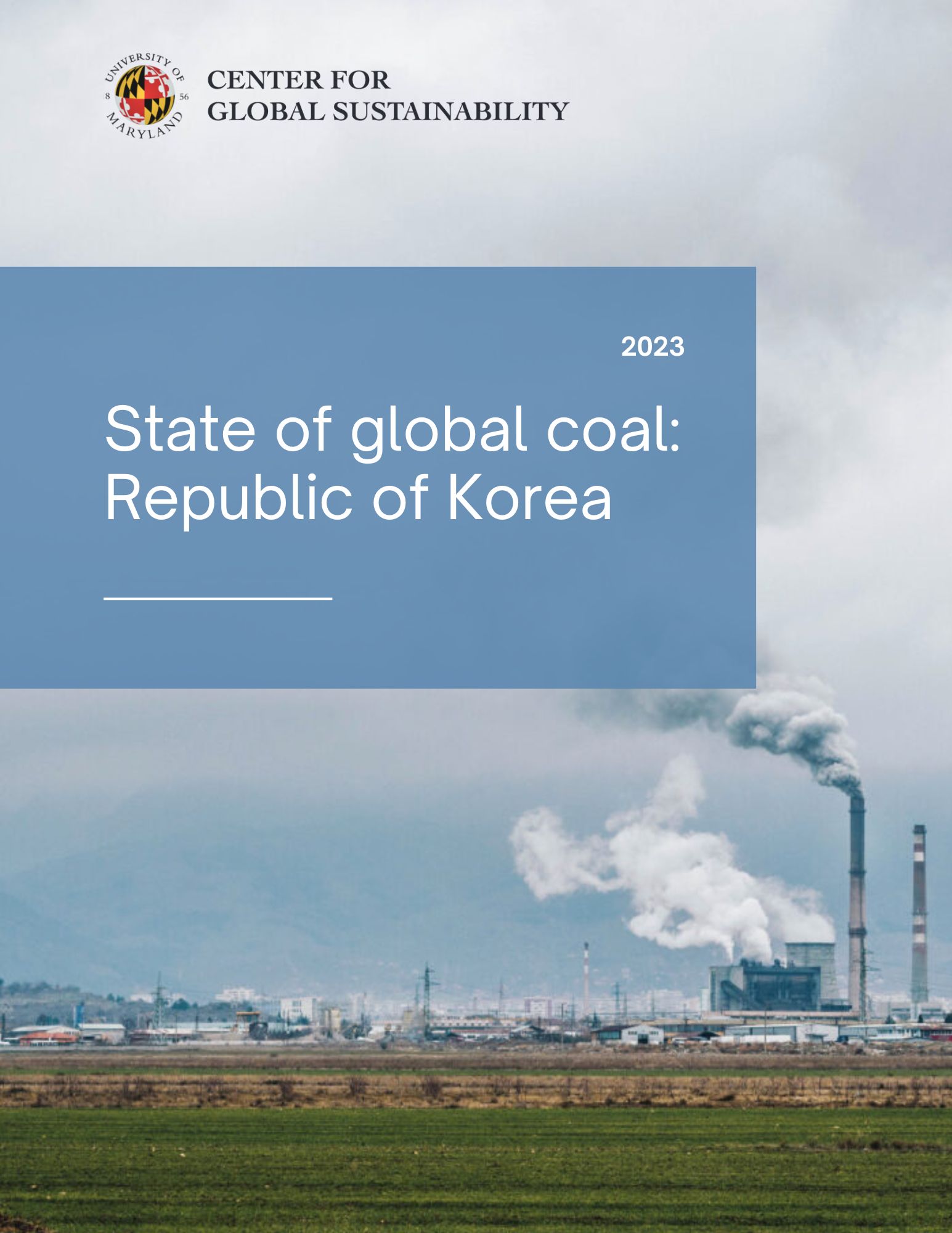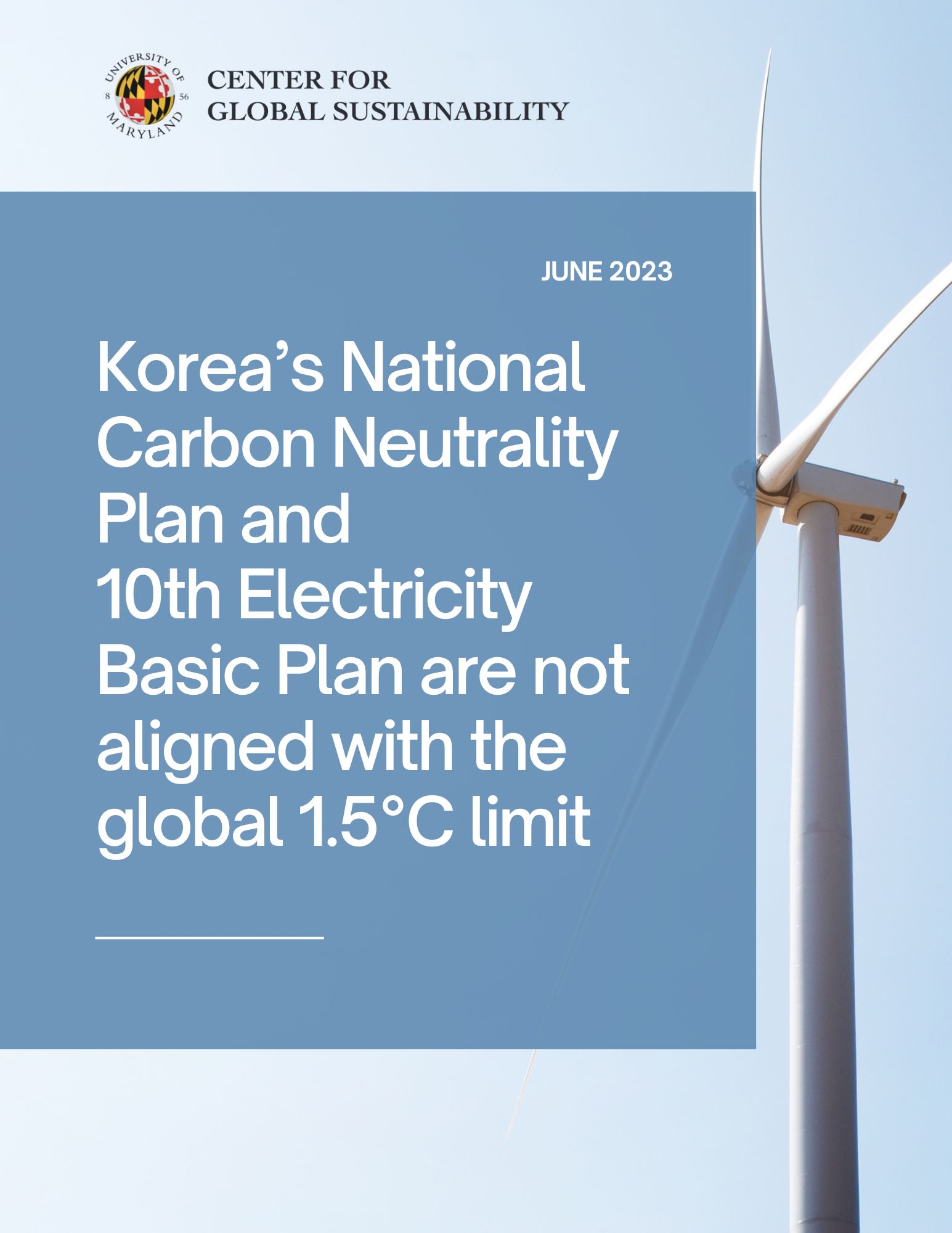Our High Ambition pathway for the Republic of Korea (South Korea) shows a 59-63% reduction of greenhouse gas (GHG) emissions (including Land Use, Land Use Change and Forestry (LULUCF)) by 2035 from 2018 levels. As of September 1, 2025, South Korea has not announced its 2035 Nationally Determined Contribution (NDC). Its 2030 NDC aims to reduce GHG emissions by 40% from 2018 levels, with 13% of total emissions reductions to be achieved through international offsets, and to reach net-zero GHG emissions by 2050.1 South Korea’s total GHG emissions, including LULUCF, peaked in 2018 and declined by 11% from 2018 to 2023 at an annual reduction rate of 2%.2 While overall emissions have been declining, achieving South Korea’s 2030 NDC target without international offsets requires doubling the average annual reduction rate from 2% between 2018 and 2023 to 5% through 2030.
A large share of South Korea’s emissions stem from power sector CO2, which comprised 32% of total GHG emissions in 2022 followed by transportation, other energy supply, and industry.3 To achieve the High Ambition 2035 target, key mitigation measures include accelerating renewable deployment; cancelling new fossil projects and phasing out coal by 2035; utilizing hydrogen-based direct reduced iron (DRI) and electric arc furnaces (EAF); and re-evaluating transportation priorities to focus on electric vehicles and charging infrastructure requirements for high-rise buildings. Limiting reliance on international offsets would enhance the credibility of climate targets by focusing on domestic emissions reductions. Additionally, reassessing the economic viability and emissions reduction potential of hydrogen and ammonia would allow South Korea to prioritize deploying proven, cost-effective technologies such as wind and solar power plants and electric vehicles to achieve greater climate ambition.
2035 Target: Total GHG Emissions Reductions
via CGS High Ambition Pathways
-59 to -63%
Relative to NDC Base Year
2018
Official 2035 NDC target
Not announced
Official 2030 NDC target
-40%
Net zero target
2050
A High Ambition pathway for South Korea shows a 59-63% reduction in total GHG emissions, including LULUCF, from 2018 levels (Figure 1). Under the High Ambition pathway, GHG emissions, including LULUCF, decline to slightly exceed the NDC target with a 42-46% reduction by 2030 fully domestically, followed by a further decline towards net-zero by 2050.
South Korea’s GHG emissions, including LULUCF, peaked in 2018 and declined by 11% from 2018 to 2023, with faster reductions in the power sector. A large share of emissions are from electricity generation, comprising 32% of emissions as of 2022, followed by transportation, other energy supply, and industry, all at 16-17%.2 While emissions have been steadily declining, largely due to reduced coal consumption in electricity generation, efforts to reduce emissions need to be maintained and further accelerated to meet the 2030 NDC and the net-zero goal. South Korea’s NDC targets a 40% reduction from 2018 levels (including LULUCF), and achieving net zero by 2050.1 South Korea plans to rely on international offsets to achieve the current 2030 NDC target, with 13% of total emissions reduction in 2030 coming from offsets. Limiting reliance on international offsets of uncertain efficacy in the 2030 and 2035 NDCs would enhance the credibility of climate targets and avoid delays in domestic transition by focusing on domestic emissions reductions. Our analysis suggests delivering this target without international offsets will require increasing the annual emissions reduction rate from 2% between 2018 and 2022 to 5% through 2030.
South Korea’s electricity generation is still largely reliant on fossil fuels. As of 2024, 31% of total generation comes from coal, 29% from gas, 30% from nuclear, and only 6% from solar and wind (Figure 2).4 The deployment of solar and wind capacity in South Korea has slowed down in recent years, from over 4 GW/year in 2020 to 3 GW in 2024. In total, 29 GW were generated in 2024 which contributed 19% of total installed capacity.4 South Korea is one of the few Organisation for Economic Co-operation and Development (OECD) countries still building coal power domestically, with 1 GW currently under construction.8 Gas-fired power plants are also expanding, with 3 GW under construction and 16 GW in pre-construction stages.8 Nuclear generation increased by 21% over the past decade.4 The country has 26 GW of installed nuclear capacity, and three reactors (4.2 GW) are under construction.4,1
Under the High Ambition scenario, South Korea's emissions from electricity generation decrease 65% between 20223 and 2035 through accelerated solar and wind deployment, expediting the planned coal phaseout, and halting the expansion of liquefied natural gas (LNG) infrastructure to avoid locking in fossil fuel infrastructure. Specifically, electricity sector transitions under the High Ambition pathway include:
- Increasing the share of renewable energy generation from 10% in 2024 to 49% by 2030 and 67% by 2035, with solar and wind accounting for 47% in 2030 and 65% in 2035, supported by buildouts of 15 GW/year from 2025 to 2030, and 13 GW/year from 2030 to 2035.4
- Decreasing the share of coal generation from 31% in 2024 to 4% by 2030, nearly phasing it out by 2035 (1%).
- Decreasing the share of gas generation from 29% in 2024 to 14% by 2035, with no new gas expansion by canceling 16 GW of pre-construction projects.
When comparing the High Ambition scenario with Korea’s 11th Basic Electricity Plan (BEP), the latter is less ambitious overall, maintaining a higher share of coal generation through 2035 (10.3% in 2038 vs. 1% in 2035 in the High Ambition scenario). The share of renewable energy generation is higher under the High Ambition scenario, achieving 49% by 2030 and 67% by 2035, exceeding the BEP targets of 22% by 2030 and 33% by 2038. Additionally, the BEP places significant emphasis on expanding technologies with uncertain mitigation potential and economic viability, including the deployment of hydrogen and ammonia which are expected to provide 2.4% of total generation in 2030 and 5.5% in 2038.7 In contrast, the High Ambition pathway relies on accelerated deployment of solar and wind energy and phase-out of coal to achieve ambitious emissions reductions without relying on these technologies. Rapidly expanding renewables, especially solar and wind, alongside nuclear energy, offer a more robust strategy to reduce power sector emissions and enhance energy security by lowering import dependence.
South Korea’s energy sector is dominated by fossil fuels and demonstrates a heavy dependence on energy imports, with industry comprising a significant share of energy use.10 The high proportion of fossil fuels within South Korea’s energy mix (31% coal and 29% gas)4 combined with the high proportion of imported energy (85%)11 makes the country highly vulnerable to global fluctuations in energy pricing.12 Under our High Ambition pathway for South Korea, domestic coal demand declines by 65% by 2030 and 82% by 2035 from the 2024 level, while gas demand falls by 25% and 50%, and oil demand decreases by 19% and 26%, respectively (Figure 3). Transitioning away from imported fossil fuels to domestic renewable energy in the power sector could significantly reduce emissions while enhancing South Korea’s energy security.
Citations
Republic of Korea. The Republic of Korea’s Enhanced Update of its First Nationally Determined Contribution.
https://unfccc.int/sites/default/files/NDC/2022/06/211223_The%20Republic%20of%20Korea%27s%20Enhanced%20Update%20of%20its%20First%20Nationally%20Determined%20Contribution_211227_editorial%20change.pdf (2021).
Gütschow, J., Pflüger, M. & Busch, D. The PRIMAP-hist national historical emissions time series (1750-2023) v2.6.1. Zenodo
https://doi.org/10.5281/zenodo.15016289 (2025).
Hoesly, R. et al. CEDS v_2025_03_18 Gridded Data 0.5 degree. Zenodo (2025).
Ember. Electricity Data Explorer - Open Source Global Electricity Data. Ember (2025).
NGFS. NGFS Climate Scenarios for Central Banks and Supervisors - Phase V. The Central Banks and Supervisors Network for Greening the Financial System (NGFS) (2024).
NGFS. NGFS Scenarios Portal. Network for Greening the Financial System (NGFS)
https://www.ngfs.net/ngfs-scenarios-portal/ (2024).
Ministry of Trade, Industry and Energy. South Korea’s 11th Basic Plan for Supply and Demand of Power (2024-2038). (2025).
GEM. Global Coal Plant Tracker (GCPT). Global Energy Monitor (GEM) (2025).
KPMG & Kearney. Statistical Review of World Energy, 73rd Edition. Energy Insitute
https://www.energyinst.org/statistical-review/resources-and-data-downloads (2024).
IEA. Energy System of Korea. IEA
https://www.iea.org/countries/korea (2023).
IEA. Korea. Energy Mix. IEA
https://www.iea.org/countries/korea/energy-mix (2023).
Institute for Energy Economics and Financial Analysis. South Korea’s misplaced faith in a fossil fuel-oriented power mix cost an additional $17bn in a year. IEEFA
https://ieefa.org/articles/south-koreas-misplaced-faith-fossil-fuel-oriented-power-mix-cost-additional-17bn-year (2024).
Our Work




